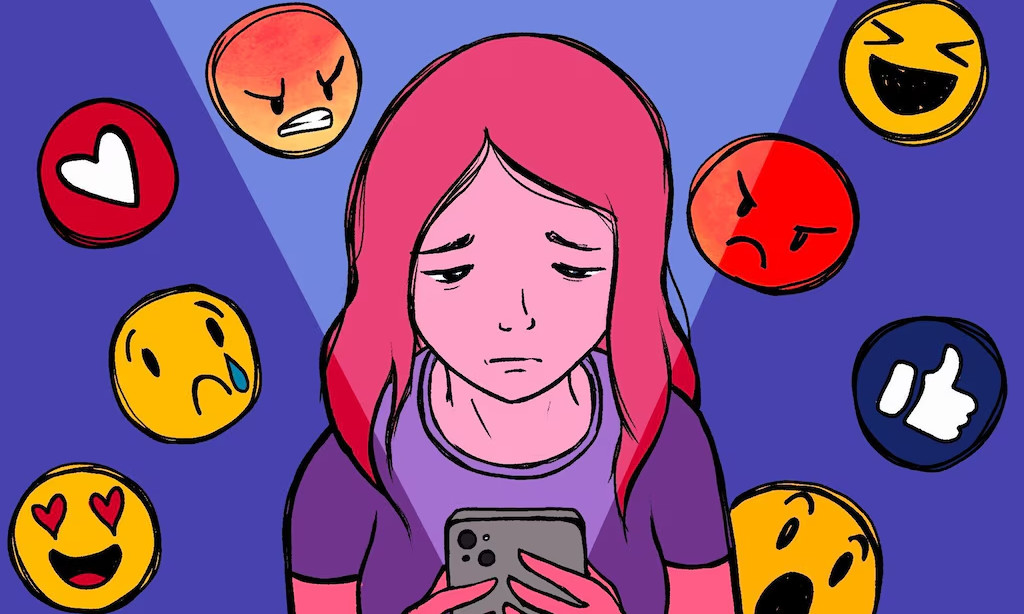We are just kids following the societal norms that the people before us created.
Note to readers • This is part of a collaborative project between The Salt Lake Tribune and the Highland High School Rambler. Amplify Utah is publishing the work through its ongoing partnership with the Tribune to elevate diverse perspectives in local media through student journalism. Read more about these young Utahns’ experiences here.
In early March, one of my teachers asked us to grab our phones and pull up our screen times. I went to my phone settings, looked at the daily average and was shocked: eight hours and nine minutes!
It made my head hurt — how is that even possible?
I am a straight-A student with a challenging schedule. I’m a cheerleader. I have a job. How is it possible that I spend one-third of my day on a screen?
Although much of this is doing schoolwork, I must admit that my love of Block Blast and Instagram has contributed to this.
Phones in the hands of every person over the age of 11 is normal, but the unwelcome result is a rising amount of average screen time, and, with it, health concerns.
According to the Centers for Disease Control, half of teenagers ages 12-17 had an average screen time of four hours or more in 2021 through 2023.
Most of my classmates shared with me that they spend more than four hours a day on their phones. Some even reported more than seven, eight or even nine hours a day. No matter how much our parents tell us to get off our phones, we can’t get away from them. Sure, we have games and social media, but much of our world depends on — and takes place on — our phones.
When I was 13, before I had a single social media account, my parents handed me an iPhone, clueless about the addiction that would soon follow. I had strict screen limits and app restrictions, but as I got older, the restrictions were removed, and my screen time increased drastically. My parents constantly criticize my screen usage, but aren’t they the people who put the phone in my hand?
Teachers — another group who criticizes our phone use — keep giving assignments that need to be completed on our screens or turned in with our phones. Once we have our phones out to do the assignment, we are but one swipe away from Instagram.
Starting in the fall, cell phones are supposed to be banned from public schools due to SB178, which was passed in the 2025 Utah legislative session. This will likely help, but I worry that it will lead to binging after school is out.
I am aware of how my actions affect my health. As I scroll through my phone, I think to myself, “I need to do something more productive than this.” So then I make a change. I stop for a week and my screen time plummets. I feel good again. But inevitably, my teachers assign work on Canvas. I need to order something for dinner, so I go online. I need to plan activities with friends, so I am back on the screen. And the vicious cycle starts again.
Adults call us “screenagers.” They tell us we are “addicted.” But this is a hollow criticism. The very generation who created the internet and smartphones are the same people who tell us we have a problem.
Ironic, right?
We are just kids following the societal norms that the people before us created, but we are being criticized for falling into the trap they set.
They must understand that the internet is what connects our entire world. It’s where we socialize, learn and entertain ourselves. This is how we all live.
Not everything needs to be accessed through a link or QR code, but criticism must be reserved for those who continue to make using a screen a daily activity. The parents who criticize us for being on our phones must understand that we follow the example that they set.
Beyond the eyes buried in screens are teenagers itching to make a change to our bad habits, but we just can’t seem to get away from the daily usage of screens.
We are known as the “problem,” and we’re told that we are addicted to our screens, but the problem we should really be considering is how to break the chain of screen time when the world constantly demands we pull out our phones.







